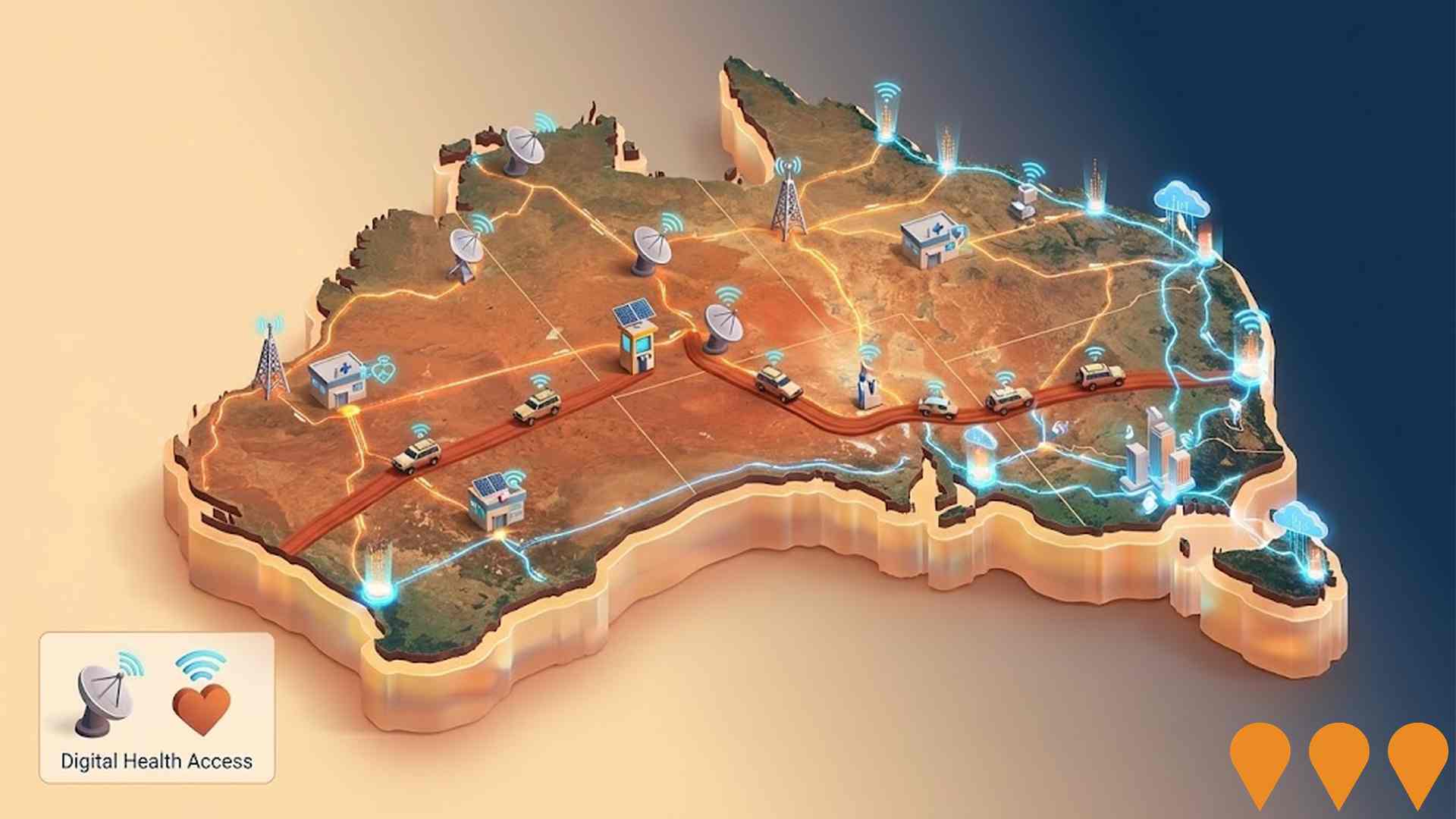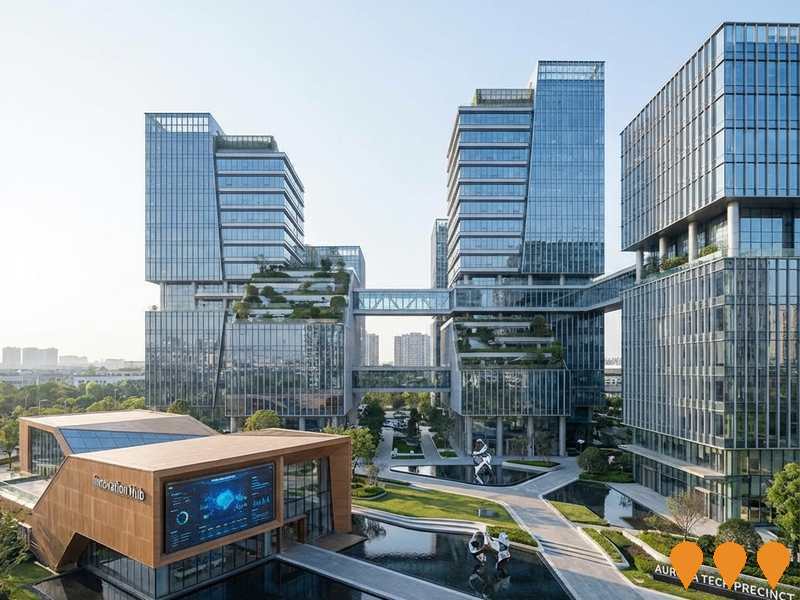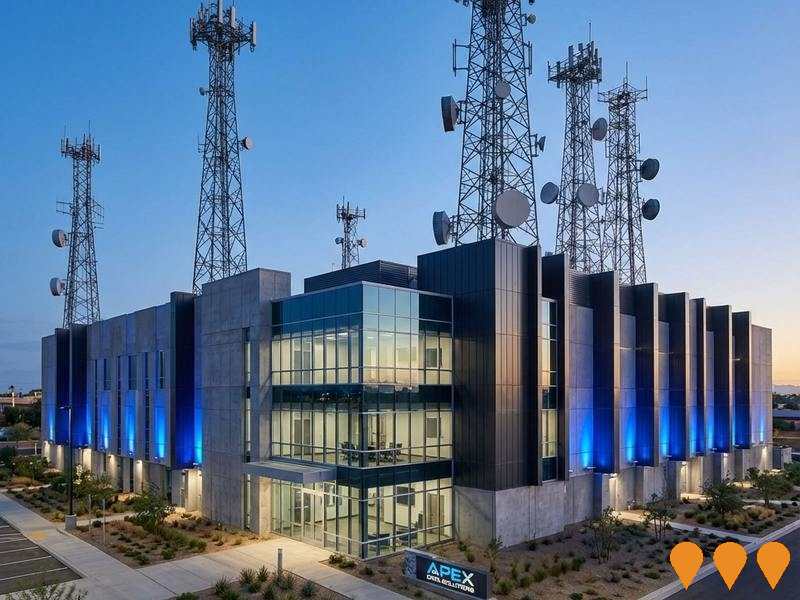Chart Color Schemes
est. as @ -- *
ABS ERP | -- people | --
2021 Census | -- people
Sales Activity
Curious about local property values? Filter the chart to assess the volume and appreciation (including resales) trends and regional comparisons, or scroll to the map below view this information at an individual property level.
Find a Recent Sale
Sales Detail
Population
Woodroffe is positioned among the lower quartile of areas assessed nationally for population growth based on AreaSearch's assessment of recent, and medium term trends
Woodroffe's population is 3,427 as of Aug 2025. This reflects an increase of 252 people since the 2021 Census, which reported a population of 3,175 people. The change is inferred from the estimated resident population of 3,427 from the ABS as of June 2024 and address validation since the Census date. This level of population equates to a density ratio of 2,141 persons per square kilometer. Woodroffe's growth rate of 7.9% since census positions it within 0.7 percentage points of the national average (8.6%). Population growth was primarily driven by natural growth contributing approximately 74.4%.
AreaSearch adopts ABS/Geoscience Australia projections for each SA2 area, released in 2024 with a base year of 2022. For areas not covered, growth rates by age cohort are applied based on ABS Greater Capital Region projections released in 2023 using data from 2022. Projecting forward, an above median population growth is expected, with the area projected to expand by 551 persons to 2041, a total increase of 16.1% over the 17 years.
Frequently Asked Questions - Population
Development
Residential development activity is lower than average in Woodroffe according to AreaSearch's national comparison of local real estate markets
Woodroffe has seen virtually no dwelling approvals in recent years. Over the past five financial years, from FY-21 to FY-25, only two homes were approved, with none so far in FY-26. This low supply is outpaced by demand, with an average of 41 people moving to the area for each dwelling built over those years.
This discrepancy typically puts upward pressure on prices and increases competition among buyers. In terms of commercial development, $558,000 worth of approvals have been recorded this financial year, indicating minimal activity in this sector compared to Woodroffe's past levels and Greater Darwin's overall activity. The constrained new construction in Woodroffe usually reinforces demand and pricing for existing dwellings, with the area's established nature and potential planning limitations indicated by its level being under the national average.
Frequently Asked Questions - Development
Infrastructure
Woodroffe has limited levels of nearby infrastructure activity, ranking in the 2ndth percentile nationally
Influence on local performance is significantly impacted by infrastructure changes. AreaSearch identified zero projects expected to affect this region. Notable projects are Darwin Light Rail Stage 1, Hudson Creek Power Station, Marine Industry Park, and Darwin Corporate Park.
Professional plan users can use the search below to filter and access additional projects.
INFRASTRUCTURE SEARCH
 Denotes AI-based impression for illustrative purposes only, not to be taken as definitive under any circumstances. Please follow links and conduct other investigations from the project's source for actual imagery. Developers and project owners wishing us to use original imagery please Contact Us and we will do so.
Denotes AI-based impression for illustrative purposes only, not to be taken as definitive under any circumstances. Please follow links and conduct other investigations from the project's source for actual imagery. Developers and project owners wishing us to use original imagery please Contact Us and we will do so.
Frequently Asked Questions - Infrastructure
Australia-Asia PowerLink (AAPowerLink)
The world's largest renewable energy infrastructure project, comprising a 17-20GW solar farm and 36-42GWh battery storage in the Barkly Region, connected via HVDC transmission to Darwin and Singapore. The project received Commonwealth environmental approval in August 2024. It aims to supply up to 4GW of green electricity to Darwin industrial customers and export power to Singapore.

Darwin Light Rail Stage 1
A proposed mass transit system, likely light rail or rapid bus, connecting Darwin CBD to Palmerston via the Stuart Highway corridor. The project aims to manage future population growth, reduce congestion, and improve connectivity between the two major population centres as part of the long-term Darwin Regional Transport Plan. While currently in the strategic planning phase with no immediate construction funding, the corridor has been identified for future preservation to support a '30-minute city' concept.

Enabling Digital Health Services for Regional and Remote Australia
National initiative to expand and improve digital health access for people in regional and remote Australia. Focus areas include enabling telehealth and virtual care, upgrading clinical systems and connectivity, supporting secure information exchange, and building workforce capability in digital health, aligned with the Australian Government's Digital Health Blueprint and Action Plan 2023-2033.

Desert Springs Octopus Renewable Energy Program
Majority Indigenous-owned developer pursuing a near-term pipeline of grid-connected solar and battery projects along the Darwin-Katherine Electricity System, with potential to expand into wind and green hydrogen. Partnership includes Octopus Australia with Larrakia Nation and Jawoyn Association to deliver utility-scale renewable energy and community benefit sharing.

National EV Charging Network (Highway Fast Charging)
Partnership between the Australian Government and NRMA to deliver a backbone EV fast charging network on national highways. Program funds and co-funds 117 DC fast charging sites at roughly 150 km intervals to connect all capital cities and regional routes, reducing range anxiety and supporting EV uptake.

Hudson Creek Power Station
12MW natural gas-fired power plant, NT's first privately owned grid-connected gas generation facility. Features 25% lower emissions than average NT gas generators. Part of dual project with Batchelor Solar Farm, creating 162 construction jobs and providing vital grid stability to Darwin-Katherine network.

Marine Industry Park
Marine and offshore industries servicing hub at East Arm, Darwin. Stage 1 planning approval is secured for a purpose-built industrial subdivision near the new Darwin Ship Lift, with expressions of interest open for serviced lots. Existing common-user facilities include an all-tide barge ramp (first point of entry) and a secure hardstand supporting storage and fabrication activities.

Darwin Renewable Energy Hub
Northern Territory Government proposal to co-locate up to six utility-scale solar farms (total 180-210 MW) with a battery energy storage system on 940 ha of Crown Land west of Finn Road, feeding the Darwin-Katherine grid. Site identified for industry in regional land use plans; consultation held to February 28, 2025 and environmental assessment processes are underway.

Employment
Woodroffe shows employment indicators that trail behind approximately 70% of regions assessed across Australia
Woodroffe's workforce is balanced across white and blue-collar jobs, with significant representation in essential services sectors. The unemployment rate was 6.1% as of June 2025, showing a 3.7% employment growth over the past year.
As of this date, 1,872 residents were employed, with an unemployment rate of 3.0%, slightly higher than Greater Darwin's 3.0%. Workforce participation was broadly similar to Greater Darwin's 69.7%. Employment is concentrated in public administration & safety, construction, and health care & social assistance. Construction stands out with an employment share 1.3 times the regional level.
Conversely, health care & social assistance is under-represented at 10.6% compared to Greater Darwin's 14.2%. Limited local employment opportunities are indicated by Census working population vs resident population counts. Between June 2024 and June 2025, employment levels increased by 3.7%, labour force by 2.9%, reducing the unemployment rate by 0.7 percentage points. In contrast, Greater Darwin experienced employment growth of 2.9% with a marginal drop in unemployment. Jobs and Skills Australia's national employment forecasts from May 2025 suggest Woodroffe's employment could grow by approximately 5.9% over five years and 12.4% over ten years, based on industry-specific projections applied to its local employment mix.
Frequently Asked Questions - Employment
Income
Income metrics indicate excellent economic conditions, with the area achieving higher performance than 75% of national locations assessed by AreaSearch
AreaSearch's latest postcode level ATO data for financial year 2022 shows Woodroffe's median income among taxpayers is $69,672. The average income in Woodroffe during this period was $76,994. This places Woodroffe among the highest income areas in Australia. In comparison, Greater Darwin had a median income of $65,522 and an average income of $75,260 during the same financial year. Based on Wage Price Index growth since financial year 2022, current estimates suggest Woodroffe's median income is approximately $78,040 and the average is around $86,241 as of September 2025. According to the 2021 Census figures, individual earnings in Woodroffe stand out at the 80th percentile nationally, with a weekly income of $1,012. The earnings profile indicates that 32.5% of Woodroffe's population (1,113 individuals) fall within the $1,500 to $2,999 income range, mirroring the broader area where 36.7% occupy this bracket. High housing costs consume 17.9% of income in Woodroffe, though strong earnings still place disposable income at the 57th percentile.
Frequently Asked Questions - Income
Housing
Woodroffe is characterized by a predominantly suburban housing profile, with above-average rates of outright home ownership
Woodroffe's dwelling structure, as per the latest Census, consisted of 80.6% houses and 19.5% other dwellings (semi-detached, apartments, 'other' dwellings), compared to Darwin metro's 70.9% houses and 24.0% other dwellings. Home ownership in Woodroffe stood at 12.7%, with mortgaged dwellings at 44.5% and rented dwellings at 42.8%. The median monthly mortgage repayment was $1,800, below Darwin metro's average of $2,037. Median weekly rent in Woodroffe was $360, compared to Darwin metro's $400. Nationally, Woodroffe's mortgage repayments were lower than the Australian average of $1,863, and rents were less than the national figure of $375.
Frequently Asked Questions - Housing
Household Composition
Woodroffe has a typical household mix, with a lower-than-average median household size
Family households comprise 71.5% of all households, including 31.7% couples with children, 21.3% couples without children, and 16.7% single parent families. Non-family households make up the remaining 28.5%, with lone person households at 24.5% and group households comprising 3.6%. The median household size is 2.6 people, which is smaller than the Greater Darwin average of 2.8.
Frequently Asked Questions - Households
Local Schools & Education
Educational outcomes in Woodroffe fall within the lower quartile nationally, indicating opportunities for improvement in qualification attainment
The area has university qualification rates of 14.8%, significantly lower than the SA4 region average of 31.3%. This presents both a challenge and an opportunity for targeted educational initiatives. Bachelor degrees are the most common at 11.2%, followed by postgraduate qualifications (1.9%) and graduate diplomas (1.7%). Trade and technical skills are prominent, with 47.0% of residents aged 15+ holding vocational credentials – advanced diplomas (9.9%) and certificates (37.1%).
Educational participation is high, with 35.9% of residents currently enrolled in formal education. This includes 13.6% in primary education, 9.6% in secondary education, and 4.4% pursuing tertiary education. The area has two primary schools: Woodroffe Primary School and Sacred Heart Catholic Primary School, serving a total of 503 students. Both schools focus exclusively on primary education, with secondary options available in surrounding areas.
Frequently Asked Questions - Education
Schools Detail
Nearby Services & Amenities
Transport
Transport servicing is good compared to other areas nationally based on assessment of service frequency, route connectivity and accessibility
Woodroffe has eight active public transport stops, all of which are bus stops. These stops are served by 26 different routes that together facilitate 1,499 weekly passenger trips. The average distance from residents to the nearest transport stop is 178 meters, indicating excellent accessibility.
On average, there are 214 trips per day across all routes, which equates to about 187 weekly trips per individual stop.
Frequently Asked Questions - Transport
Transport Stops Detail
Health
The level of general health in Woodroffe is notably higher than the national average with prevalence of common health conditions low among the general population though higher than the nation's average across older, at risk cohorts
Woodroffe demonstrates above-average health outcomes with a low prevalence of common health conditions among its general population, although this rate is higher than the national average among older and at-risk cohorts.
Approximately 58% (1,980 people) of Woodroffe's total population has private health cover, which is exceptionally high. The most prevalent medical conditions in the area are asthma and mental health issues, affecting 7.9% and 7.5% of residents respectively. Conversely, 73.0% of residents declare themselves completely clear of medical ailments, compared to 76.6% across Greater Darwin. Woodroffe has a higher proportion of elderly residents aged 65 and over, with 9.6% (327 people) compared to the 7.5% in Greater Darwin. This demographic requires more attention than the broader population.
Frequently Asked Questions - Health
Cultural Diversity
The level of cultural diversity witnessed in Woodroffe was found to be above average when compared nationally for a number of language and cultural background related metrics
Woodroffe's cultural diversity was above average, with 17.9% of its population born overseas and 14.6% speaking a language other than English at home. Christianity was the predominant religion in Woodroffe, comprising 39.3% of people. Buddhism was overrepresented compared to Greater Darwin, making up 2.2% of Woodroffe's population versus 2.3%.
The top three ancestry groups were Australian (27.2%), English (21.7%), and Australian Aboriginal (12.5%). Some ethnic groups had notable divergences: Filipino was overrepresented at 4.2% in Woodroffe compared to the regional average of 4.8%, Maori at 1.0% versus 0.7%, and Spanish at 0.5% versus 0.3%.
Frequently Asked Questions - Diversity
Age
Woodroffe's young demographic places it in the bottom 15% of areas nationwide
Woodroffe's median age in 2021 was 33 years, comparable to Greater Darwin's average of 34 and lower than Australia's median of 38. Compared to Greater Darwin, Woodroffe had a higher proportion of residents aged 55-64 (12.9%) but fewer residents aged 25-34 (15.6%). Post-2021 Census data showed the 55-64 age group grew from 10.4% to 12.9%, while the 45-54 cohort declined from 14.6% to 12.7% and the 15-24 group dropped from 12.4% to 11.3%. By 2041, demographic modeling suggests Woodroffe's age profile will change significantly. The 45-54 age cohort is projected to grow steadily, increasing by 110 people (25%) from 434 to 545. Meanwhile, the 0-4 cohort grows by a modest 3% (7 people).




